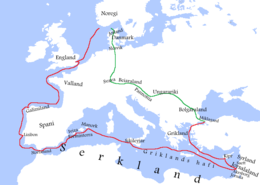| Siege of Lisbon (1109) | |||||||||
|---|---|---|---|---|---|---|---|---|---|
| Part of the Norwegian Crusade and the Reconquista | |||||||||
 Map of the route taken during the Norwegian Crusade | |||||||||
| |||||||||
| Belligerents | |||||||||
| | Taifa of Badajoz | ||||||||
| Commanders and leaders | |||||||||
| | Unknown | ||||||||
| Strength | |||||||||
| 60 ships | Unknown | ||||||||
| Casualties and losses | |||||||||
| Low | Unknown, high | ||||||||
The siege of Lisbon (Norwegian : Beleiringen av Lisboa) was a military campaign and siege at the city of Lisbon in 1109, with the Norwegian Realm fighting the Iberian Muslims in and around the city. The Norwegians eventually won, suffering very low casualties. The siege in particular had a significant impact on Lisbon because of the ongoing Christian and Muslim conflicts on the Iberian Peninsula.